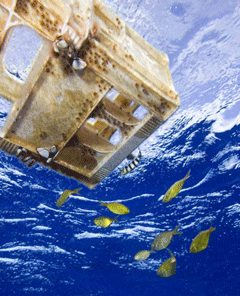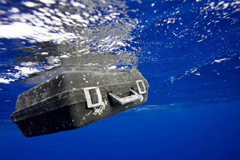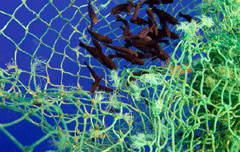Trash Vortex
Air Date: Week of November 17, 2006

Fish swim amongst an abandoned plastic crate.(Photo: © Greenpeace/Alex Hofford)
Researchers have discovered a Texas-sized area of trash floating in the Pacific Ocean. Composed primarily of plastic garbage from landlubbers, the area has become both a major threat to marine life and a frightening example of how polluted our oceans are. Living on Earth speaks with Adam Walters, a scientist for Greenpeace who is monitoring the vortex aboard the vessel Esperanza.
Transcript
GELLERMAN: Scientists have discovered a Texas-sized piece of the Pacific Ocean that’s sort of a magnet for garbage. They call it the “trash vortex.” In the calm waters halfway between Hawaii and the coast of California, they’ve found hundreds of millions of tons of flotsam--much of it is plastic. Adam Walters is a consulting scientist with Greenpeace International Research Lab, which is investigating the “trash vortex.”
He joins us by ship-to shore phone from the Greenpeace vessel Esperanza. Adam, where are you right now?
WALTERS: Currently we’re heading towards San Diego. We’re about 500 miles off the Californian coast.
GELLERMAN: So, were you in the trash vortex recently?
WALTERS: We’ve been close to the area where the plastic accumulates, yes.
GELLERMAN: What is it? It sounds something like a Bermuda Triangle in reverse. Instead of getting lost forever, whatever is in this vortex stays around forever.
WALTERS: Yeah, I mean that’s a pretty fair analogy. Basically what happens is that for most of the summer in this one area of the North Pacific about halfway between Hawaii and the US mainland, a high-pressure cell sits. This creates a very calm area of ocean surface. And as the currents circle around the whole of the North Pacific in a clock-wise direction plastic passes by this area and enters the calm and essentially just stays there.

Fish swim amongst an abandoned plastic crate. (Photo: © Greenpeace/Alex Hofford)
WALTERS: We’re finding incredible amounts of plastic. When we use our sampling device which collects pieces down to a third of a millimeter in size we see a massive increase in the amount of plastic that we’re collecting as we approach this area of accumulation.
GELLERMAN: Where is all this plastic coming from? Cruise ships, fishing ships?
WALTERS: UNEP the United Nations Environment Program, estimate that 80 percent of the plastics found in the ocean actually originate from land. Now it’s not a point source problem. This is coming from everywhere around the North Pacific. Potentially if you have a landfill site near the coast its going to be blowing off there. You see these huge clouds of plastic in some places, literally just blowing out to sea.
Another major source is storm drains. You have people littering on the streets then you get a massive downpour of rain. The storm drains come into action and wash all that plastic straight out to sea.
GELLERMAN: So what kind of stuff is it? What are you finding?
WALTERS: We’re finding an incredibly diverse range of plastic articles out here. Everything from lost fishing gear such as nets and floats through to a workman’s hard hat which had a fish living in it. Right down to marker pens and toothbrushes. Just about anything made of plastic has a chance of being out here.

The contents of this suitcase are probably best kept contained. (Photo: © Greenpeace/Alex Hofford)
WALTERS: This is based on the research of Charles Moore of the Algalita Marine Research Foundation. And yes, he found that by dry weight the plastic outweighed the plankton six to one. If you consider that the plankton is acting as food for a lot of organisms out here in that area of ocean for every kilogram of plankton of food that they’re consuming they would consume six kilograms of plastic if they were not selective in their feeding.
GELLERMAN: Is the plastic toxic to sea life, and maybe more to the point, if I eat a fish that’s eaten plastic, is it toxic to me?
WALTERS: Now this is an interesting question and one that we currently don’t know the answer to. We’ve known about plastic being out in the ocean for decades. However, the range of effects it’s causing on marine life out here is only now becoming clear.
GELLERMAN: Are you finding trash vortexes in other oceans then?

Pieces of lost fishing gear, like this “ghost” net, will trawl the ocean, collecting organisms, for years. (Photo: © Greenpeace/Alex Hofford)
GELLERMAN: So, Adam what can be done about all this plastic in the ocean? I mean somehow we’ve got to prevent it from getting in the ocean I guess.
WALTERS: Indeed. That’s the main thing that we have to do. To clean up the oceans would be an incredible task. The most important thing we have to do right now is to stop the flow of plastic into the sea. Now because the plastic is not coming from one point source all levels of society need to act if we are to have any effect on the amount of plastic that’s pouring out into the ocean.
GELLERMAN: Well, Adam have a good voyage.
WALTERS: Thank you very much, yes. I’m looking forward to us hitting the coast and it warming up a little bit.
GELLERMAN: Adam Walters is a consulting scientist with Greenpeace International Research Lab. We spoke to him from the Greenpeace Research Vessel Esperanza.
To see pictures and learn more about the “trash vortex” visit our website, www.loe.org.
Links
Living on Earth wants to hear from you!
Living on Earth
62 Calef Highway, Suite 212
Lee, NH 03861
Telephone: 617-287-4121
E-mail: comments@loe.org
Newsletter [Click here]
Donate to Living on Earth!
Living on Earth is an independent media program and relies entirely on contributions from listeners and institutions supporting public service. Please donate now to preserve an independent environmental voice.
NewsletterLiving on Earth offers a weekly delivery of the show's rundown to your mailbox. Sign up for our newsletter today!
 Sailors For The Sea: Be the change you want to sea.
Sailors For The Sea: Be the change you want to sea.
 The Grantham Foundation for the Protection of the Environment: Committed to protecting and improving the health of the global environment.
The Grantham Foundation for the Protection of the Environment: Committed to protecting and improving the health of the global environment.
 Contribute to Living on Earth and receive, as our gift to you, an archival print of one of Mark Seth Lender's extraordinary wildlife photographs. Follow the link to see Mark's current collection of photographs.
Contribute to Living on Earth and receive, as our gift to you, an archival print of one of Mark Seth Lender's extraordinary wildlife photographs. Follow the link to see Mark's current collection of photographs.
 Buy a signed copy of Mark Seth Lender's book Smeagull the Seagull & support Living on Earth
Buy a signed copy of Mark Seth Lender's book Smeagull the Seagull & support Living on Earth

